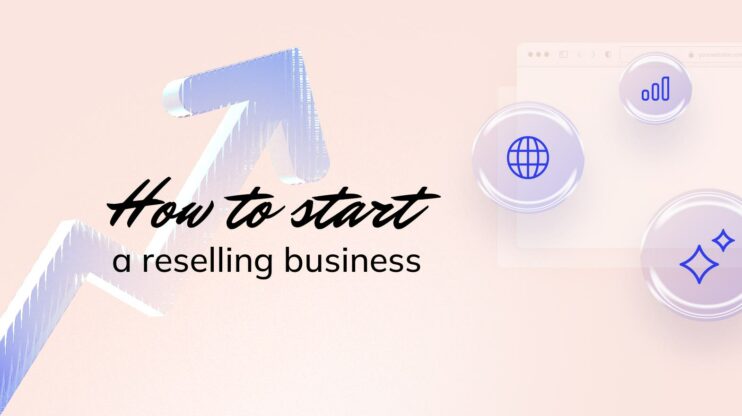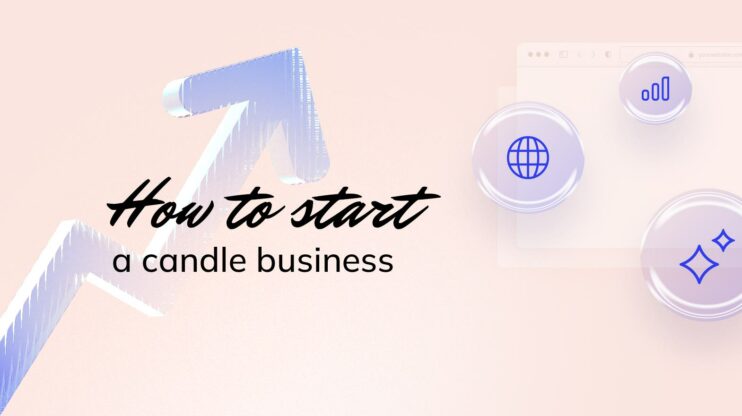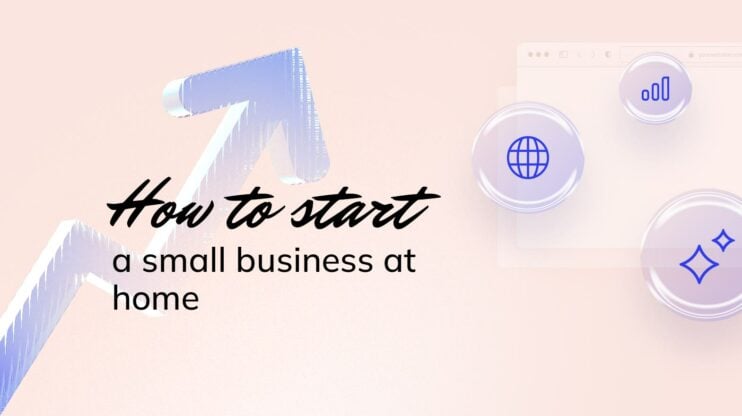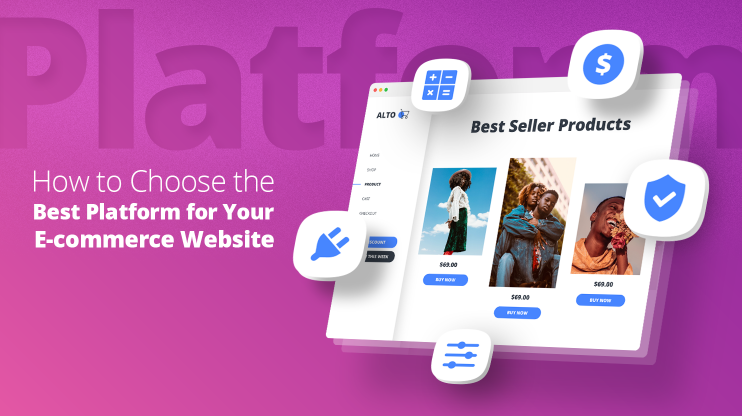Starting a wholesale business seemed simple at first – until I actually dove in. While the basic steps might look simple on paper, I quickly learned that the real challenge lies in how you approach each aspect of setting up your business.
To help others avoid the confusion I faced, I’ve put together a useful guide covering the 7 most crucial steps to launching your wholesale business. And since funding is often the biggest challenge for new entrepreneurs, I’ve included some valuable financial tips at the end.

Looking to sell online?
Create your custom online store in minutes with 10Web AI Ecommerce Website Builder and take your business online.
1. Understand the wholesale business and market
First, let’s understand the wholesale business and market. This will create realistic expectations and a foundation for growth.
What is a wholesale business
If you start a wholesale business, you’ll serve as a middleman. Your job will be buying products in bulk from manufacturers and selling them to retail stores, who then sell to customers. It’s all about connecting the big producers to the smaller businesses that sell to people.
The current and future market
You need to really know your wholesale market to make sure your business does what it’s supposed to and gives people what they want.
My online research showed a clear image – the wholesale market is getting bigger fast. It’s worth about $53.8 trillion globally in 2024 and experts think it’ll hit $7.31 trillion by 2029.
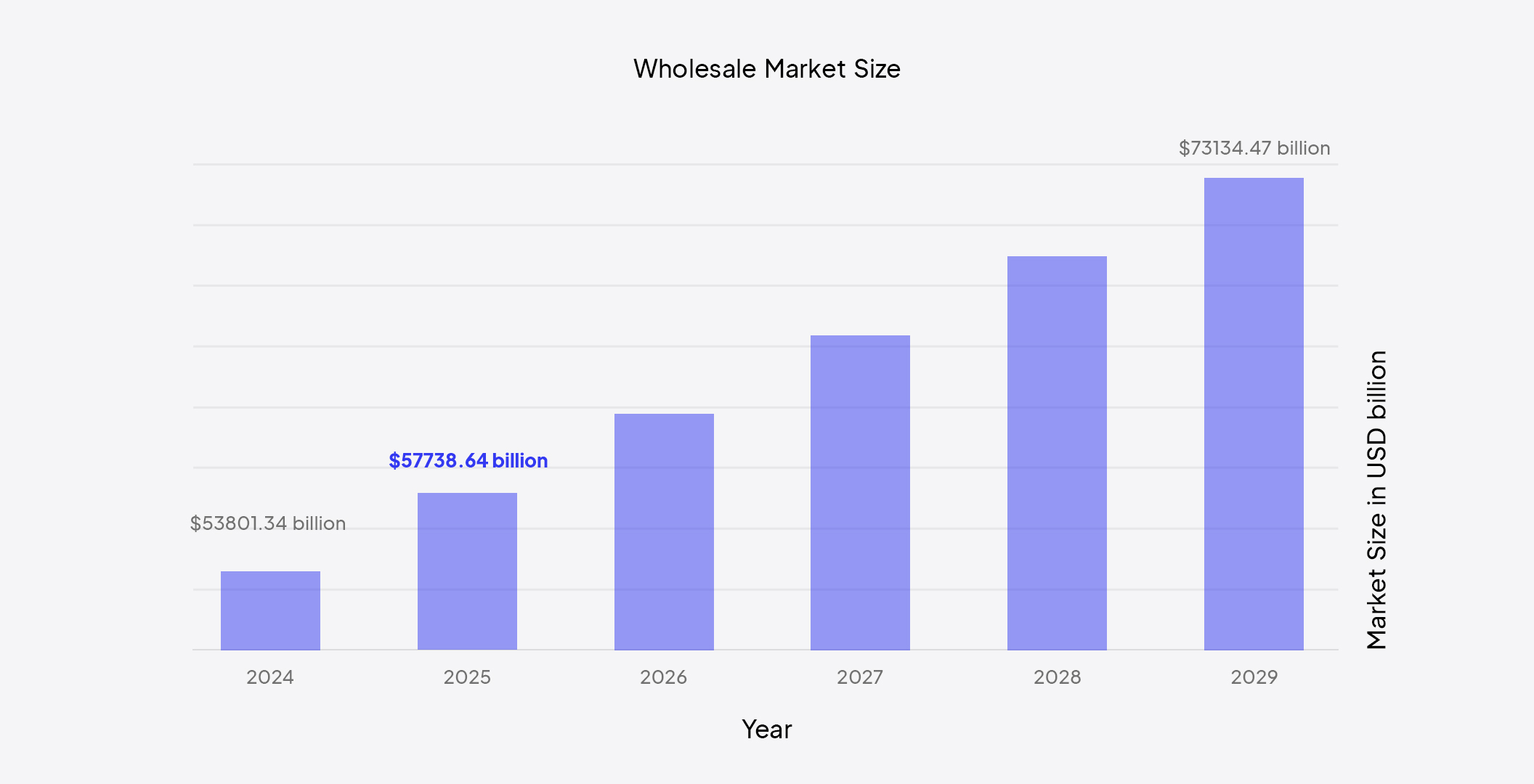
Just in the U.S., wholesale sales went up from $658.4 billion to $673.7 billion between January and February 2024. This growth is happening because more people want easy-to-use online platforms and new types of products.
However, you should look closer at your local market too. Check what’s happening in your area, study your nearby competition, and understand what your specific customers need so you can offer the right products.
Your market research checklist
- Check what products sell well, when they sell best, and what’s missing in the market
- Find good suppliers – compare their prices, reliability and reputation
- Use software to track what customers want and buy
- Look at your closest competitors – what they sell, their prices, and how they work
- Talk to potential customers (retail stores) about what products they need
- Calculate startup costs – storage space, delivery trucks, staff, inventory
- Check rules and licenses you need to operate in your area
- Research payment terms other wholesalers offer to retailers
- Plan how you’ll store and deliver products
- List ways you’ll find new customers
- Figure out your minimum order sizes and pricing tiers
- Check trade shows and industry events you should attend
2. Develop a clear business plan
A business plan shows how you’ll run your wholesale business. It maps out your goals, costs, and expected sales in clear numbers. It also helps you check out what other wholesalers are doing and lets banks/investors see if they want to lend you money.
Your target market
Understanding your specific market helps you sell what customers actually want. To know your market:
- Demographics: Find out how old your buyers are, where they live, and how much they can spend.
- Business types: Choose who you’ll sell to – stores, other wholesalers, or specific businesses like restaurants or clothing shops.
- Needs and preferences: Learn what matters most to them – lower prices, better quality, or faster shipping.
Matching your business to what customers want helps you find and keep them, while showing you how to sell better.
Setting business objectives
After looking at your market, turn what you learned into clear goals. Define objectives that are:
- Specific: Write down exactly what you want, like “get 20 customers in 6 months.”
- Measurable: Use real numbers, like “make $50,000 in year one.”
- Achievable: Pick goals you can reach with your current money and tools.
Start with basic goals like finding your first customers and setting up reliable suppliers. Later goals can focus on growing bigger, adding new products, or moving into different areas. Always include money targets, like keeping steady profits, to stay on track.
Conceptualize your plan
At the end your research and goals come down to daily steps. This is what your business plan should show: the big picture and the daily steps.
I recommend, including these four main parts:
- Executive summary: Write a short overview of what your business does, what you sell, and who you sell to. Keep it short but interesting.
- Market analysis: Share what you learned about your customers and other sellers. Include current trends and who your customers are, showing you know your market well.
- Operational plan: Explain how you’ll run things daily – getting products, managing stock, and sending orders. List who does what to keep everything running smooth. This might be one of the most complicated steps for someone who’s just starting out. I will address it in the coming sections in more detail.
- Financial plan: List your startup costs and expected money coming in and going out. Show how you’ll price things and when you’ll start making profit. I have included a section in the end for financial tips I gathered from experts that you can use.
A solid plan helps you make good choices and shows banks or partners why they should work with you.

Looking to sell online?
Create your custom online store in minutes with 10Web AI Ecommerce Website Builder and take your business online.
3. Set up your legal and financial framework
Having the right legal structure will lay a strong foundation for your wholesale business.
The right business structure
A Limited Liability Company (LLC) works well for wholesale businesses. Your personal assets stay protected from business debts with an LLC. You can manage it flexibly and set it up more easily than a corporation.
With an LLC, you have a tax advantage. The money your business makes only gets taxed once – when you report it on your personal tax return. Other business types can get taxed twice – once when the business makes money, and again when that money goes to you. This means you keep more of what you earn.
Before you choose any business structure, consider three main things: how it protects you, how much you’ll pay in taxes, and how much paperwork you’ll need to do. Since these can be tricky to figure out on your own, it’s a good idea to talk to a lawyer who can help you make the best choice for your situation. Consult a legal advisor for personlized assistance.
Necessary permits and licenses
Before you can run your wholesale business legally, you need several important documents. Here’s what to do:
First, you need to register your business name with your state government office. If you need help picking a business name, you can use the 10Web Business Name Generator. You just type in a few words about your business, and it gives you many name options right away, which saves you time.
Next, you need to get an Employer Identification Number (EIN) from the IRS – this is for your taxes. You’ll also need to get a basic business license from your city or town government to run your business legally.
You’ll need a wholesale license too – this lets you buy products at lower prices and sell them to stores. Some products, like alcohol or guns, need extra special permits.
Make sure to check with your local and state government offices to find out exactly what you need in your area. Getting all these legal documents helps make sure your wholesale business can keep running smoothly.
4. Build supplier relationships and manage inventory
Strong relationships with suppliers are the foundation of any successful wholesale business. The sections below walk through the important elements that help keep operations running smoothly.
Finding reliable suppliers
Finding good suppliers who won’t let you down helps you get better products at better prices, which your wholesale business needs to succeed. Look them up in online lists, read what other people say about them, and go to industry events. These ways help you find suppliers that other businesses trust and who know what they’re doing.
After you find some suppliers you might want to work with, ask them to send you some of their products to try out. This lets you see if their products are good enough for what you need and what your customers want. This also helps to avoid future problems.
If you can, go visit where the supplier makes their products. Watching how they make things shows you if they’re reliable, how much they can make, and how they check that everything is good quality. Meeting them in person also helps build trust and makes working together easier.
Last, look at how long the supplier has been in business to make sure they’ll stick around. Suppliers who have worked in the business for a long time usually have shown they can make good products and do a good job over and over. Working with suppliers that other people trust makes your business run better and keeps your customers happier.
Contract and payment term negotiations
After you have passed the initial stage, effective contract negotiation ensures a clear understanding between you and your supplier.
Some challenges may arise during this process, but by addressing them proactively, you can set the stage for a successful supplier partnership. Here’s a table with possible challenges and how to handle them:
| Challenge | Description | Solution |
| Gaining supplier trust | Suppliers may be unsure about working with new businesses. | Share your business plan, show growth potential, and start with small orders. |
| Limited options for niche products | Specialized products may have fewer supplier options. | Look at international markets or use industry-specific directories. |
| High order requirements | Suppliers may require large orders you can’t afford at first. | Negotiate smaller orders or team up with others to meet the minimum. |
| Communication issues | Language and time differences can make discussions difficult. | Use clear language, translators, or local agents to help communicate better. |
| Tough payment terms | Upfront payments or strict terms may strain your budget. | Ask for flexible terms like paying 30 or 60 days after receiving goods. |
5. Establish a warehouse and logistics system
Last year, I published an academic business paper about operations management. While researching it, I visited warehouses and offices of Coca Cola HBC and other major producers, speaking with operations managers and directors to understand their practices. This hands-on research made one thing clear: well-managed inventory and logistics are your operational core. They help you cut costs, save time and labor, and increase earnings when managed correctly. So, it’s important to give them proper attention.
Suitable warehouse location
Picking the right spot for your warehouse really matters to keep things moving smoothly from suppliers to customers. Choose a warehouse that’s in a good spot to both get items from suppliers and send them to customers.
Think about:
- Easy to get to: Being near highways and shipping routes to save money on shipping.
- Enough room: Space to store things, pack orders, and grow bigger later.
- Keep things safe: Ways to stop theft and protect your items from getting damaged.
Think about how much space the warehouse has, both for now and later. Make sure there’s enough room to store everything, pack orders, and add more items if you need to. Check what security they have to keep your items safe from theft and damage.
Being able to get in and out easily is also really important. A warehouse that big trucks can easily get to and that’s set up well inside can make loading and unloading much faster. Make sure to check what the local rules are about using the building as a warehouse and get any permits you need to run your business legally in that area.
Basics of inventory management
When I talked to producers and wholesalers during my research, I noticed that year after year, they were investing more effort and resources into optimizing their inventory management. One distribution manager showed me how a seemingly minor inventory mistake had once cost them thousands of dollars in spoiled products – a lesson that led them to completely rebuild their tracking system.
All the successful operators I interviewed mentioned several key aspects of inventory management that proved crucial to their success:
- Sort your items: Put similar things together based on their size, what they are, or how often you use them. Put clear tags and barcodes on everything so you can keep track of what you have and make fewer mistakes.
- Use inventory management software to track everything: Programs like QuickBooks or Fishbowl help you watch your stock levels, keep track of orders, and make reports that help you make better choices. These programs can work with online stores like WooCommerce to make things easier.
- Sell older items first: Use the “first in, first out” method to make sure you sell older items before newer ones. This stops things from going bad or getting too old to sell. This really helps when you sell things that can spoil.
- Use your space well: Make the most of your space with shelves, keeping similar items near each other where you can reach them easily. When everything has its place, you can fill orders faster and more accurately.
- Check your stock regularly: Looking at what you have every so often helps you find mistakes, stop things from going missing, and keep your records correct.
Optimized supply chain processes
To keep your wholesale business running well, you need to make sure everything flows smoothly from your suppliers to your customers. You have already set up good relationships with suppliers and shipping companies you can trust. Keep checking your deals with them and try to get better prices when you can.
Using software can make everything work better. Getting inventory management software that helps you track what you have in stock and orders new items automatically when you’re running low. This helps make sure you don’t run out of things or end up with too much.
Keep track of important numbers like how long orders take, if orders are correct, and how many orders you can fill. Look at these numbers carefully to see what you need to fix and to guess what might happen in the future. Make backup plans in case something goes wrong. This means knowing other suppliers you can buy from and different ways to ship things if your usual way isn’t working.
6. Create an online and marketing presence
When the operational part is set up, you need to promote yourself. Building a good website and using the correct social media will be you first steps here.
Your professional website
A wholesale website works like your online catalog. It shows your bulk products and lets business buyers learn and order easily. Here’s how to build a good one:
- Pick your web address: Choose an easy name that shows you’re a wholesaler. Keep it business-focused.
- Make it easy to use: Build pages where retailers can quickly find bulk pricing and place large orders.
- Show clear photos: Take good pictures that show product details and bulk packaging.
- Write good descriptions: Tell business buyers everything – case quantities, pallet sizes, and minimum orders.
This is not as complicated as it seems, because you can use platforms and tools like the 10Web AI Ecommerce Website Builder to have your website ready in a few clicks. This is the AI tool that builds your website automatically based on what you sell. You can then change colors, layouts, and more to match your brand.
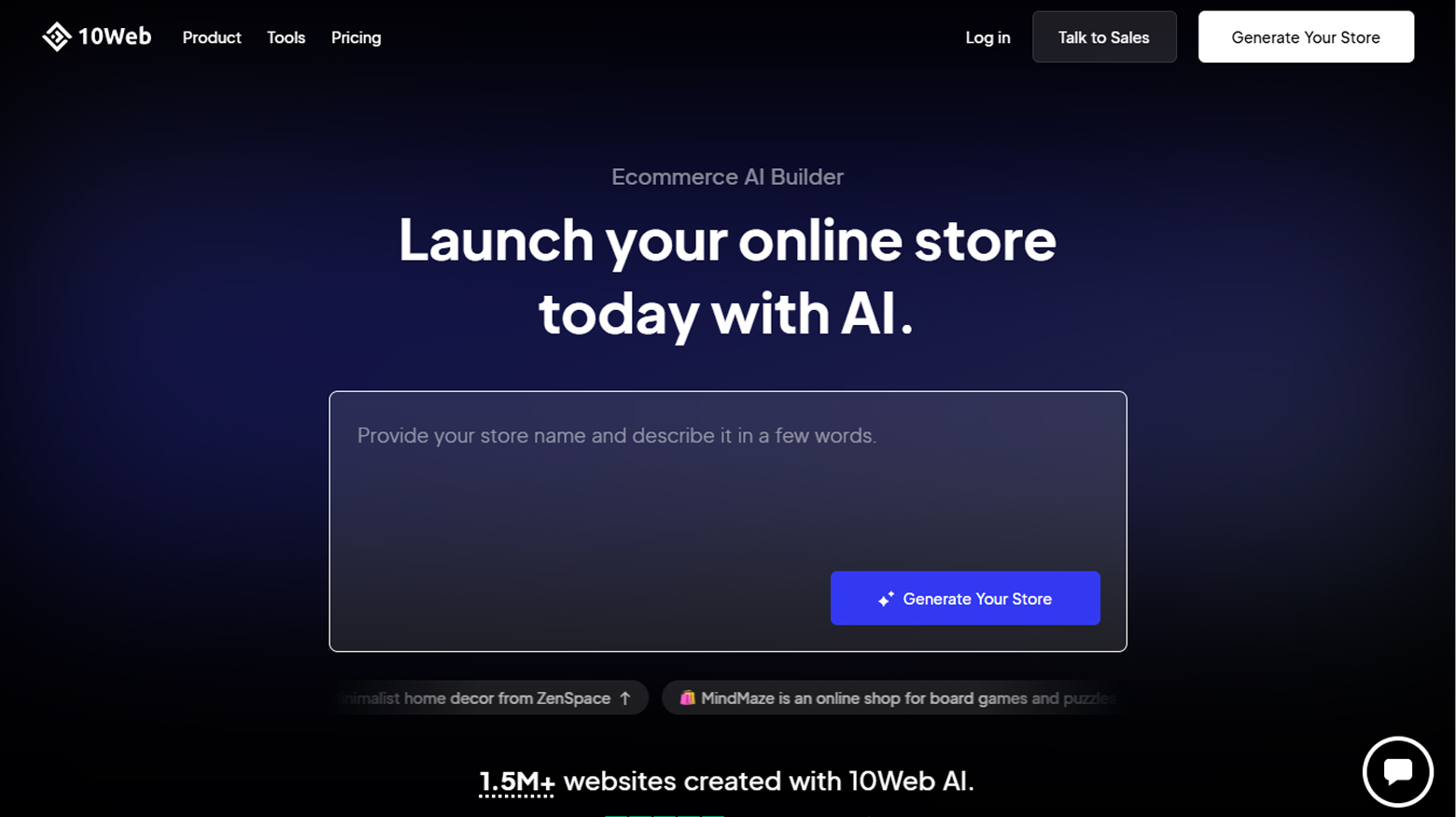
- Visit the 10Web AI Ecommerce Website Builder – Enter a short description of your wholesale business and click Generate Your Website to start the process.
- Choose your website and store type – Choose the online store option and select your store type.
- Provide your store information – Add your company name and refine your business description if needed.
- Define product categories – Enter your product categories and let AI automatically generate a structured website for you.
- Refine your website structure – Adjust the suggested layout if necessary, knowing you can always customize it later.
- Personalize your design – Experiment with fonts, colors, and styles to match your brand identity.
- Generate your website – Click Generate to create your fully designed website in seconds.
With these steps, your basic wholesale website site is set up and ready for further customization.

Looking to sell online?
Create your custom online store in minutes with 10Web AI Ecommerce Website Builder and take your business online.
Social media and B2B platforms
I remember the first time I needed to reach out to someone for direct B2B sales, and it was scary. And based on my experience, the more you do it, the easier and better it gets. You can even approach this as a networking opportunity, because many stores probably already have wholesalers they trust, but might keep you on the list or recommend you to someone. In both cases, do not write spam-like reachout messages.
Social media and B2B platforms help you find more retailers and make bulk sales. They let you connect with store owners and show them your wholesale catalog.
Logically, you should start with setting up your business accounts. LinkedIn, Meta Business, and industry networks. You can also consider TikTok, since it is also gaining momentum in B2B sales thanks to content marketing.
Share consistent, valuable content across platforms – focus on bulk deals, discounts, and market insights that matter to business buyers. From my experience, while paid B2B ads can build awareness among retailers and business owners, they’re often better for visibility than immediate sales, especially when starting out. Building trust takes time and can’t be rushed through advertising alone. Actively engage with buyers by responding promptly to wholesale inquiries and proactively reaching out for direct sales opportunities.
Finally, try to lead all your channels to sales. You can also list your bulk products on sites like Alibaba or Global Sources. Or build your own wholesale portal using the AI Builder. Doing these things helps more retailers find your wholesale business and place bulk orders by staying connected with them.
7. Deliver exceptional customer service and expand your reach
Strong customer relationships are key to wholesale success. This section covers tips to provide great service, simplify your processes, and expand into new markets.
Exceptional customer service
Good service helps you keep customers and find new ones in the wholesale business. Train your team to answer questions fast and professionally. Listen to what customers say to make your service better.
Make ordering easy. Give retailers a simple online system to place orders and see where they are. This is why you need a good online store to start with. You also need a reliable CRM (Customer Relationship Management) system. It helps you keep track of all your customer information in one place. Think of it as a smart address book that remembers everything about your buyers. It shows you what they buy most and helps you suggest products they might like.
Choosing a CRM system can be hard, but this guide with 9 beginner-friendly options will help you. After you have all the information in place, you can give special deals to keep customers coming back. Try bulk discounts, rewards for loyal buyers, and personal attention to their needs. Stay easy to reach. Have someone ready to answer calls, emails, or chat messages. Quick answers often keep customers from going to other suppliers.
Growing your market
To expand your business, look at new markets. Study possible markets in your country and abroad. Find areas where people want your products and make a plan to sell there.
Meet new sellers by going to trade shows and events. These places help you connect and get new clients.
Put money into B2B marketing. Use social media and emails to show your products to new customers. Provide sample cases to potential retailers, letting them see your product quality and wholesale packaging.
Remember how powerful word-of-mouth is. Ask satisfied retailers to recommend your wholesale business to other stores in their network. Give volume discounts or priority shipping for successful distributor referrals.

Looking to sell online?
Create your custom online store in minutes with 10Web AI Ecommerce Website Builder and take your business online.
Money tips and more
While researching, I came across a Reddit post from a few years ago. The person was asking something that everyone considering opening a wholesale business asks themselves: “How realistic is it to start a wholesale distributor business?” Both the author and the community highlighted two challenges: networking and finances. I have addressed supplier relationships (the network) but didn’t go too deep into the money, so let’s do that here.
Securing funding
Firstly, where to find money for the initial investment?
Here are different ways to get money for your business:
- Using your own money: Many people use their savings to start a business. While this means you don’t owe anyone money, you might not have enough saved up to do everything you want to do.
- Asking family and friends: You can ask people you know to invest in your business. Just make sure to be completely honest about how you’ll use their money and write down all the details of your agreement. This helps prevent any hurt feelings or damaged relationships later.
- Getting a bank loan: Banks can lend you large amounts of money, but they’ll want to see that you have good credit and own something valuable (like a house) that they can take if you can’t pay them back.
- Finding individual investors: These are wealthy people who give you money in exchange for owning part of your business. They often have experience running companies and can give you helpful advice.
- Using crowdfunding websites: Sites like Kickstarter let you collect small amounts of money from many different people. Usually, you give them something in return, like being the first to get your product or receiving special rewards.
Before you choose any of these options, think carefully about what’s best for your business. Also consider how much control of your company you’re willing to share with others.
Money management strategies
In a recent episode of the Business Credit and Financing Show, guest expert Jack McGuinness shared some valuable advice that aligns perfectly with the challenges wholesale business owners face.
“A true test of a great team is the ability to be resilient and get back up when you get knocked down and do that in a productive way. Because things, particularly in fast-paced environments, don’t always go the way you want. You don’t get that next round of funding, or you’re wondering where the money’s going to come to pay payroll.”
This advice perfectly matches what wholesale business owners need to think about. It’s important to manage your money well using good methods:
- Watch your cash flow: Cash flow means the money coming in and going out of your business. Keep track of this daily or weekly so you can spot when you might have too little money (shortages) or extra money (surpluses) ahead of time. Think of it like watching your checking account to make sure you’ll have enough money when bills are due.
- Work out good payment timing: Talk with your customers about when they’ll pay you and work with your suppliers about when you need to pay them. Try to arrange it so the money comes in from customers before or around the same time you need to pay your suppliers. This helps keep your cash flow positive, which means having enough money on hand when you need it.
- Control what you spend: Look at all your business expenses regularly. Find places where you can spend less money without hurting the quality of your products or making your business less efficient.
- Save money for emergencies: Put some money aside regularly into a cash reserve (like a savings account for your business). This gives you a safety net for unexpected costs or times when business is slow and less money is coming in.
Using these strategies helps keep your business financially healthy and helps it grow over time.
When McGuinness talks about being “resilient,” he’s describing what happens when you follow smart money management strategies. Having these systems in place means that when you do face a setback – like a delayed payment from a customer or an unexpected expense – you have the resources and plans ready to handle it without panicking.
Conclusion
Setting up a wholesale business is simpler when you break it down into steps. This guide walks you through the basics, from picking your market to keeping customers happy – so grab a pen and start planning your business today.
Get started by getting your paperwork in order, finding good suppliers, and setting up your storage system. Then build your website, take care of your customers, and watch your business grow in this booming market. Ready to launch your wholesale business with a professional online presence? Tools like 10Web AI Ecommerce Website Builder make it easy to create a powerful wholesale website that attracts buyers and streamlines your operations. Take the first step today—start building your wholesale store with 10Web!

Looking to sell online?
Create your custom online store in minutes with 10Web AI Ecommerce Website Builder and take your business online.
FAQ
How to start with no money? Can I run it from home? How to sell online? Do I need a business license? What are the steps in the USA? Where can I find wholesale lists? How to sell to small retailers? What do I need to get started? How profitable can it be?









